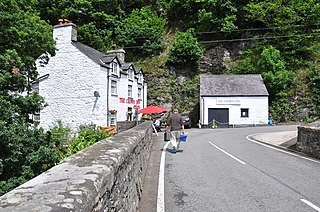
Maelgwn Gwynedd was King of Gwynedd during the early 6th century. Surviving records suggest he held a pre-eminent position among the Brythonic kings in Wales and their allies in the "Old North" along the Scottish coast. Maelgwn was a generous supporter of Christianity, funding the foundation of churches throughout Wales and even far beyond the bounds of his own kingdom. Nonetheless, his principal legacy today is the scathing account of his behavior recorded in De Excidio et Conquestu Britanniae by Gildas, who considered Maelgwn a usurper and reprobate. The son of Cadwallon Lawhir ap Einion and great-grandson of Cunedda, Maelgwn was buried on Ynys Seiriol, off the eastern tip of Anglesey, having died of the "yellow plague"; quite probably the arrival of Plague of Justinian in Britain.
Beli ap Rhun was King of Gwynedd. Nothing is known of the person, and his name is known only from Welsh genealogies, which confirm that he had at least two sons. He succeeded his father Rhun Hir ap Maelgwn as king, and was in turn succeeded by his son Iago. Beli was either the father or grandfather of Saint Edeyrn.
Rhun ap Maelgwn Gwynedd, also known as Rhun Hir ap Maelgwn Gwynedd, sometimes spelt as 'Rhûn', was King of Gwynedd. He came to the throne on the death of his father, King Maelgwn Gwynedd. There are no historical records of his reign in this early age. A story preserved in both the Venedotian Code and an elegy by Taliesin says that he waged a war against Rhydderch Hael of Alt Clut and the kings of Gododdin or Manaw Gododdin. The small scattered settlement of Caerhun in the Conwy valley is said to be named for him, though without strong authority. Rhun also appears in several medieval literary stories, as well as in the Welsh Triads. His wife was Perwyr ferch Rhûn "Ryfeddfawr" and their son was Beli ap Rhun "Hîr".

Owen Jones, known by his bardic name of Owain Myfyr, was a Welsh antiquarian.

The Honourable Society of Cymmrodorion, often called simply the Cymmrodorion, is a London-based Welsh learned society, with membership open to all. It was first established in 1751 as a social, cultural, literary and philanthropic institution. It fell into abeyance between 1787 and 1820, and again between 1843 and 1873. In its second and third incarnations its interests have been predominantly cultural and antiquarian. The present society claims continuity from that founded in 1751, although the three successive societies have in fact been slightly different in character and aims.
Richard Morris was a Welsh writer and editor, a younger brother of Lewis Morris.
This article is about the particular significance of the year 1771 to Wales and its people.

St David's School was an independent girls' school in Ashford, England. The school was originally established in London in 1716 as the British Charity School or Welsh Charity School. It was located in a purpose-built home on Clerkenwell Green from 1738, before moving to Gray's Inn Road in 1772, and eventually to Ashford in 1857. It was at first a boys' school, and then from 1758 co-educational, but from 1882 it began to admit girls only and became known as the Welsh Girls' School. It changed its name to St David's School in 1967, and closed in 2009.

The Cambrian Archaeological Association was founded in 1846 to examine, preserve and illustrate the ancient monuments and remains of the history, language, manners, customs, arts and industries of Wales and the Welsh Marches and to educate the public in such matters. The association's activities include sponsoring lectures, field visits, and study tours; as well as publishing its journal, Archaeologia Cambrensis, and monographs. It also provides grants to support research and publications.
Robert Thomas Jenkins CBE was a Welsh historian and academic.
John Evans was a Welsh Anglican cleric, known for his attacks upon Methodism.
The Dictionary of Welsh Biography (DWB) is a biographical dictionary of Welsh people who have made a significant contribution to Welsh life over seventeen centuries. It was first published in 1959, and is now maintained as a free online resource.
The Gwyneddigion Society was a London-based Welsh literary and cultural society. The original society was founded in 1770 and wound up in 1843. It was briefly revived in 1978. Its proceedings were conducted through the medium of Welsh.
Cymdeithas Cymreigyddion y Fenni, which translates as the Abergavenny Welsh Society, is a Welsh language society in Abergavenny.
The Cymreigyddion Society was a London-based Welsh social, cultural and debating society, which existed from 1794 or 1795 until about 1855.
Edward Jones, nicknamed "Ginshop" Jones, was a Welsh Calvinistic Methodist "exhorter" and lay preacher in London, who ended his life in disgrace.

Llanfihangel Glyn Myfyr is a village and community in Conwy County Borough, in Wales. It is located within the historic county of Denbighshire on the Afon Alwen, at the south western edge of the Clocaenog Forest, 9.1 miles (14.6 km) north west of Corwen, 2.5 miles (4.0 km) east of Cerrigydrudion and 27.5 miles (44.3 km) south of Conwy. At the 2001 census the community had a population of 195, reducing to 189 at the 2011 census.
This article is about the particular significance of the year 1731 to Wales and its people.
This article is about the particular significance of the year 1715 to Wales and its people.

This is a bibliography of published works on the history of Wales. It includes published books, journals, and educational and academic history-related websites; it does not include self-published works, blogs or user-edited sites. Works may cover aspects of Welsh history inclusively or exclusively.







